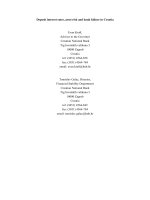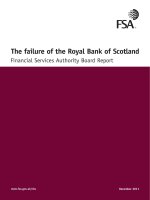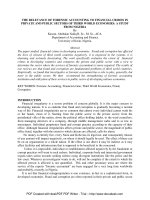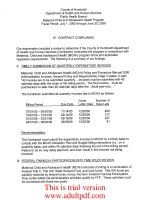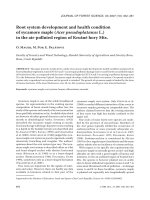friedman & kraus - engineering the financial crisis; system risk and the failure of regulation (2011)
Bạn đang xem bản rút gọn của tài liệu. Xem và tải ngay bản đầy đủ của tài liệu tại đây (3.23 MB, 223 trang )
Engineering
the Financial Crisis
This page intentionally left blank
UNIVERSITY OF PENNSYLVANIA PRESS
PHILADELPHIA
Engineering
the Financial Crisis
Systemic Risk
and the Failure
of Regulation
Jeffrey Friedman
and
Wladimir Kraus
Copyright ᭧ 2011 Jeffrey Friedman and Wladimir Kraus
All rights reserved. Except for brief quotations used
for purposes of review or scholarly citation, none of this
book may be reproduced in any form by any means without
written permission from the publisher.
Published by
University of Pennsylvania Press
Philadelphia, Pennsylvania 19104-4112
www.upenn.edu/pennpress
Printed in the United States of America
on acid-free paper
10987654321
Library of Congress Cataloging-in-Publication Data
Friedman, Jeffrey, 1959–
Engineering the financial crisis : systemic risk and the failure of
regulation / Jeffrey Friedman and Wladimir Kraus. — 1st ed.
p. cm.
ISBN 978-0-8122-4357-4 (hardcover : alk. paper)
Includes bibliographical references and index.
1. Basel Accord (1988). 2. Basel II (2004). 3. Global
Financial Crisis, 2008–2009. 4. Bank capital—Law and
legislation. 5. Banks and banking—Risk management.
6. Economics—Political aspects. 7. Financial crises—United
States—History—21st century. I. Title. II. Kraus, Wladimir.
HB3717 2008.F75 2011
330.9Ј0511—pcc 2011024456
CONTENTS
List of Figures and Tables vii
Glossary of Abbreviations and Acronyms ix
Introduction 1
1
Bonuses, Irrationality, and Too-Bigness: The Conventional Wisdom About
the Financial Crisis and Its Theoretical Implications 5
2
Capital Adequacy Regulations and the Financial Crisis: Bankers'
and Regulators' Errors 57
3
The Interaction of Regulations and the Great Recession: Fetishizing Market Prices 86
4
Capitalism and Regulation: Ignorance, Heterogeneity, and Systemic Risk 112
Conclusion 144
Appendix I. Scholarship About the Corporate-Compensation Hypothesis 157
Appendix II. The Basel Rules off the Balance Sheet 163
Notes 175
References 189
Index 201
Acknowledgments 211
This page intentionally left blank
FIGURES AND TABLES
Figures
1.1 Fed funds rate, mortgage interest rates, house prices 9
1.2 Business lending, investment, unemployment 12
1.3 Decline in bank lending to businesses 14
1.4 Growth of subprime bond bubble 48
1.5 Bubble bursts: house prices and delinquency 49
2.1 Rise of private-label MBS 69
2.2 Rise of asset-backed securities 71
2.3 Rise (and fall) of asset-backed commercial paper 72
2.4 Steady bank leverage before crisis 80
2.5 Largest banks shift into low-risk-weighted assets 82
3.1 Falling ``price'' of mortgage bonds 96
3.2 Accounting and capital-adequacy regulations 99
II.1 Rise and fall of U.S. asset-backed commercial paper 170
Tables
1.1 Distribution of mortgage bonds 13
1.2 Securities exposures of banks 34
1.3 Bankers' preference for safety 42
2.1 Risk weights under Basel regimes 74
2.2 U.S. bankers' search for capital relief 77
2.3 Overconcentration of private-label MBS 79
This page intentionally left blank
GLOSSARY
ABCP asset-backed commercial paper (short-term funding issued by OBSEs)
ABS asset-backed securities (such as an MBS)
ABX a source of price indices for MBS insurance via CDS
AIG American International Group
ARM adjustable-rate mortgage
BCBS Basel Committee on Banking Supervision
BHC bank holding company
BIS Bank for International Settlements (located in Basel, Switzerland)
CCF credit conversion factor
CDO collateralized debt obligation (derivative that tranches pools of MBS)
CDS credit-default swap (insurance against default)
CFTC Commodities Futures Trading Commission
Fannie Mae Federal National Mortgage Association
FDIC Federal Deposit Insurance Corporation
Fed Federal Reserve Bank
FAS Financial Accounting Standards
FASB Financial Accounting Standards Board
Freddie Mac Federal Home Loan Mortgage Corporation
GDP gross domestic product
Ginnie Mae Government National Mortgage Association
GLBA Gramm-Leach-Bliley Act
GSE government-sponsored enterprise (e.g., Fannie Mae, Freddie Mac)
HELOC home-equity lines of credit
HUD Department of Housing and Urban Development
IFRS International Financial Reporting Standards
IMF International Monetary Fund
IRB internal ratings-based option of Basel II
LIBOR London Interbank Offered Rate
LTCM Long-Term Capital Management
x Glossary
LTV loan-to-value ratio (of a mortgage)
MTM mark-to-market (or ``fair value'') accounting
MBS mortgage-backed security
NRSRO Nationally Recognized Statistical Rating Organization
OBSE off balance-sheet entity
OCC Office of the Comptroller of the Currency
OTS Office of Thrift Supervision
OTTI other-than-temporarily impaired
PLMBS private-label MBS
SEC Securities and Exchange Commission
SIV Structured Investment Vehicle
S & P Standard & Poor's
SPE special-purpose entity
SPV special-purpose vehicle
TARP Troubled Asset Relief Program
TBTF too big to fail
INTRODUCTION
This is not the ordinary book about the financial crisis. The product of a
collaboration between an economist (Kraus) and a political theorist (Fried-
man), it is designed for readers who are interested not only in what caused
the financial crisis, but in what those causes indicate about the nature of
capitalism and of modern government. Along the way to considering these
questions in Chapter 4, we discuss some of the methodological and logical
conundrums of contemporary economics and of the modern political cul-
ture that shapes contemporary economics (Chapter 1). In Chapters 1, 3,
and 4, and Appendix I, we criticize the tendency of both contemporary
economics and contemporary politics to overlook human ignorance—as a
general phenomenon and as a possible cause of the crisis. We hope that
these aspects of the book make it interesting to historians, philosophers,
legal theorists, political scientists, and sociologists as well as to economists
and educated laypeople.
In brief, we argue that:
1. There is no evidence that the crisis—as opposed to the housing bub-
ble—was caused by the lending practices of Fannie Mae and Freddie
Mac (Chapter 1).
2. There is no evidence that the crisis was caused by banks’ conviction
that they were ‘‘too big to fail,’’ and thus that they would be bailed
out by the government if they made wild bets on mortgage-backed
securities (Chapter 1).
3. There is no evidence that the crisis was caused by banks’ compensa-
tion practices, which tended to reward profit making but not to
penalize loss making (Chapter 1).
4. There is no evidence that the crisis was caused by anyone’s ‘‘irra-
tional exuberance’’ (Chapter 1).
2 Introduction
5. There is evidence, of a kind, that deregulation caused the crisis. What
we mean is that regulations can be envisioned that, in retrospect,
would have prevented the crisis. But in Chapter 1, we criticize the
conflation of ex post facto policy prescriptions with causal explana-
tions. This confusion of what did happen with what ‘‘should’’ have
happened is a deformity of scholarship that we attribute to the ‘‘pol-
icy mindset’’ encouraged by modern politics.
6. There is evidence that the crisis was caused by capital-adequacy regu-
lations, which influence the leverage ratios of banks around the
world and, more important, the types of assets banks hold. Basel I
(1988), the first international agreement on capital-adequacy regula-
tion, required banks to use twice as much capital for business and
consumer loans as for mortgages. Basel II (2005) required banks to
use five times as much capital for business and consumer loans as
for mortgage-backed securities (MBS) that were rated AAA. During
the consultative process that eventually culminated in Basel II, U.S.
financial regulators enacted a capital-adequacy regulation that was
applicable only to American banks, the Recourse Rule (2001), which
also required five times as much capital for business and consumer
loans as for triple-A MBS. The Recourse Rule, in particular, appears
to have encouraged U.S. banks to accumulate nearly a half-trillion
dollars of triple-A MBS. This, we contend, was the proximate cause
of the financial (i.e., banking) crisis (Chapter 2).
7. The financial crisis was transmitted into the nonfinancial or ‘‘real’’
economy through a lending contraction that began in mid-2007, as
banks were required to ‘‘mark to market’’ their holdings of mort-
gage-backed securities in line with market fears (which culminated
in the panic of September 2008) about the value of these securities,
due to rising rates of subprime mortgage delinquencies. Our evi-
dence concerning the lending contraction is presented in Chapter 1,
in the section entitled ‘‘How the Great Recession Began’’; our evi-
dence about the role of accounting rules is presented in Chapter 3.
8. The triple-A ratings on MBS were conferred by three bond-rating
corporations—Moody’s, Standard and Poor’s (S&P), and Fitch—
that had been protected from competition by a Securities and
Exchange Commission regulation dating back to 1975. Not only
bankers but investors of all kinds were either unaware that these
three corporations were protected, or they were unaware of the
Introduction 3
implications of this protection for the accuracy of their ratings. This
lack of awareness was apparently shared by the banking regulators,
who had incorporated the three companies’ ratings into the Recourse
Rule and Basel II (Chapter 3).
Chapter 1 assesses (and chiefly debunks) various elements of the con-
ventional wisdom about what caused the financial crisis. Readers who are
interested solely in our own explanation for the crisis, however, should not
pass up Chapter 1 entirely, because it contains a key element of the story:
the mechanics of mortgage-backed securities. These are explained, as
accessibly as possible for a general readership, in the section of Chapter 1
entitled ‘‘How Private Mortgage Bonds Worked.’’
As for the broader questions raised by the crisis, we do not offer
unequivocal answers, but the answers we offer are, at least, unusual ones.
From what we can tell, the crisis was caused by ignorance on all sides.
The bankers who bought mortgage-backed bonds were ignorant of the vul-
nerability of these securities to a downturn in housing, or (more likely)
they were ignorant of the likelihood of such a downturn; the regulators
who encouraged banks to accumulate mortgage-backed bonds were simi-
larly ignorant. Clearly the regulators had no idea that their actions might
eventually have such disastrous consequences, but in retrospect the chair of
the Federal Deposit Insurance Corporation (FDIC) has now admitted that
the Recourse Rule was a terrible mistake that is explained by the regulators’
ignorance of the potential consequences (Chapter 4).
John Maynard Keynes once wrote, about the unpredictability of the
future: ‘‘We simply do not know!’’ A casual observer of the financial crisis
might think this to be obvious—after all, why else would bankers take
actions that could well have destroyed their banks, or regulators actions
that could well have destroyed the banking system?—but the academic dis-
cipline of economics is, we contend, so preoccupied with ‘‘incentives’’ that
economists tend to think that whatever happens in our complex world is
deliberately brought about by agents who have a self-interested stake in the
outcome, no matter how disastrous that outcome. Genuine mistakes caused
by our ignorance of a complicated reality have little place in mainstream
economists’ theoretical models.
1
Caricaturing only slightly, economists tend
to think that everything that happens must have been envisioned by eco-
nomic ‘‘agents’’ who had a perfect understanding of the world, and thus an
infallible grasp of the results to which their actions would lead.
4 Introduction
The world these agents navigate must, by implication, be a very simple
one, pellucid and easy to understand. This simplistic perspective has an
eerie similarity to the conspiracy theorizing that haunts popular political
discourse, so the economists’ theory-driven ‘‘too-big-to-fail’’ (TBTF) and
corporate compensation stories were perfectly suited to gain wide popular-
ity, and they have. But in this case ‘‘the people’’ are wrong.
More important for present purposes is that economic experts were the
ones who created these myths about the financial crisis. We believe that this
fact gets to the heart of the wider, systemic issue raised by the crisis, so in
writing this book we have not hesitated to name the names of celebrated
economists whose pronouncements about the crisis amount to uninten-
tional mythmaking, as we see it. The fallibility of experts strikes us as cru-
cial, not only because so many of them have been mistaken in their
retrospective evaluations of what caused the crisis, but because other
experts were just as mistaken when they forecast benign results from the
capital-adequacy and accounting regulations that, we contend, contributed
mightily to the crisis and the recession. Yet none of these experts are blame-
worthy (we would be the last to contend that they knowingly committed
their errors); they did their best, given the constraints of human ignorance
and fallibility.
This situation produces a genuine dilemma for political as well as eco-
nomic theory, for if not experts, who else can we turn to when dealing with
a complex world? What alternative is there but to place the regulation of
capitalism in expert hands? We discuss these questions in Chapter 4.
1
Bonuses, Irrationality,
and Too-Bigness: The Conventional Wisdom
About the Financial Crisis
and Its Theoretical Implications
By the end of 2010, six elements of conventional wisdom about the causes
of the financial crisis had taken root:
1. The very low interest rates from 2001 to 2005 fueled a virtually
unprecedented nationwide housing bubble in the United States.
2. Fannie Mae and Freddie Mac, the two government-sponsored enter-
prises (GSEs), helped cause the crisis by loosening their lending stan-
dards.
3. Deregulation of finance allowed the ‘‘shadow banking sector’’ to
originate subprime loans and securitize them.
4. The compensation systems used by banks, especially the payment of
bonuses for revenue-generating transactions, encouraged bankers to
bet huge amounts of borrowed money (leverage) on the continua-
tion of the housing boom by buying mortgage-backed bonds. The
bankers would be richly rewarded if these bets paid off, but they
would not be penalized if the bets went sour.
5. The bankers knew their banks were ‘‘too big to fail’’ (TBTF), and
they invested recklessly because they were confident they would be
bailed out if disaster struck.
6. Irrational exuberance led investors to buy securities backed by sub-
prime mortgages, oblivious to the fact that when housing prices
eventually declined, such mortgages would be likely to default.
6 Chapter 1
In this chapter, we will confront the six items of conventional wisdom
with hard evidence and, we hope, sound reasoning in order to clear the
ground for our own argument: that, stripped to its essentials, the crisis was
a regulatory failure in which the prime culprit was none of the usually
targeted factors, but was, instead, the set of regulations governing banks’
capital levels known as the Basel rules.
When we began researching the financial crisis in the early months of
2009, we were driven by our dissatisfaction with the analyses then on offer.
At the time, there were (understandably) only hypotheses that lacked evi-
dence, and many of them, while equally plausible, contradicted each other.
Additionally, there were more hypotheses than the six we have just listed,
and partly as a result of the profusion of theories about the crisis there was
also a widespread recognition that nobody had yet explained convincingly
what had gone wrong. The extant paradigms of economics were found want-
ing, and fresh thinking was deemed not only possible but mandatory. This
made the financial crisis not only an important topic because of the human
tragedy to which it led, but an exciting field of research intellectually.
Very soon, however, politicians and political ideologues began to treat
the hypotheses that confirmed their predilections as if they were established
facts, and these theories eventually formed the conventional wisdom. Thus,
conservatives were eager to blame the crisis on the government by means
of hypotheses 1, 2, and 5, while liberals were eager to blame the crisis on
capitalism by means of hypotheses 3, 4, and 6.
There were also scholarly forms of special pleading. Most of the aca-
demic commentary on the crisis has been written by professional econo-
mists, and for all practical purposes, the one weapon in professional
economists’ armory is rational-choice theory. This amounts to saying that
the one causal variable that economists are able to identify is the ‘‘incen-
tive,’’ known to the rest of us as ‘‘the profit motive.’’ If an economic catas-
trophe occurs, then to most economists it must have been due to perverse
incentives. Items 4 and 5, the bonus hypothesis and the TBTF hypothesis,
fit the economists’ template perfectly: each theory posits an incentive for
bankers to have engaged in reckless behavior so they could profit from it.
However, there has been a tendency to confuse the mere assertion that
these incentives existed with a demonstration that they actually caused the
crisis. Nobel laureate economist Joseph E. Stiglitz (2010b, 153), who
embraces both the TBTF and the bonus hypotheses, writes without irony
that ‘‘the disaster that grew from these flawed incentives can be,
Bonuses, Irrationality, and Too-Bigness 7
to us economists, somewhat comforting: our models predicted that there
would be excessive risk-taking and short-sighted behavior, and what has
happened has confirmed these predictions.’’ Even when Stiglitz wrote those
words, however, evidence was already available that, as we shall see, seri-
ously undermines the assumption that the disaster did grow from these
flawed incentives.
The crisis has also provided grist for the mill of economists who would
like to jettison the orthodox academic focus on the incentives faced by
rational agents. These economists (e.g., Akerlof and Shiller 2009) have pop-
ularized the notion of irrational exuberance, hypothesis 6. Our objection to
this hypothesis is that its misuse of psychologistic terminology has created
the impression that there was something peculiarly emotional about the
behavior that caused the crisis, even though there is evidence that bankers
merely erred—not that they ‘‘went crazy.’’
Our criticisms of the conventional wisdom may seem unfair. Journalists
first popularized many of the dominant claims about the crisis, and under
the pressure of deadlines they often have little choice but to repeat the
pronouncements of experts and to draw on the analysis of ideologues. For
this reason, journalism is usually seen as, at best, the first draft of history:
in the long run, journalistic conclusions are supposed to be corrected and
superseded by scholarship. The same process of correction and supersession
is also, as Max Weber ([1918] 1946) reminded us long ago, the fate of all
scholarly endeavors. As the hasty pronouncements about the financial crisis
that have been made by many journalists—and scholars—are challenged
over time, specialists may come to repudiate what is today the received
view.
However, the received view has immediate and important conse-
quences. The informed public’s impressions of the crisis are based in part
on journalists’ and scholars’ hasty pronouncements. These impressions
have now hardened into convictions. Political movements of the right and
the left are already acting upon dogmas about the crisis that have little or
no basis in fact, and policy changes have been made on the basis of these
dogmas. Moreover, mass attitudes that have been formed in the crucible of
an economic catastrophe cannot be expected to change even if, in the
future, careful scholars overturn the assumptions that were the basis for
these attitudes. Therefore, we think it is crucial to test the various hypothe-
ses against the available evidence immediately, although we are sure that
some or all of our evidence is bound to be superseded, as Weber forecast,
8 Chapter 1
and that some of our analysis may be flawed. The basic evidence presented
in this chapter is already a matter of public record, however, and the analy-
sis of it is relatively straightforward. Once one confronts the conventional
wisdom with this evidence, most elements of the received view crumble,
and we are left with the questions that initially made the crisis interesting
as well as significant.
The conventional wisdom about the causes of the crisis contains kernels
of truth, but most of the rest is demonstrably incorrect. In this chapter, we
clear away the underbrush of myth so that we can reclaim the topic for
scholarly inquiry. In the process, we will explore some of the tacit assump-
tions that have commonly led very intelligent and knowledgeable scholars,
especially economists, to endorse theories about the crisis that have no
apparent basis in reality.
The Limited Role of Low Interest Rates
There is empirical evidence for a modified version of the first thesis—that
low interest rates fueled the housing bubble, as opposed to the financial
crisis. Stanford’s John B. Taylor (2010) has demonstrated rigorously that
not only in the United States, but across the European Union, low interest
rates correlated with housing booms during the first half of the decade.
The Federal Reserve Bank (the Fed) and the European Central Bank
lowered interest rates from 2001 to 2004, with the Federal Funds Rate fall-
ing from 6.5 percent in January 2001 to 1 percent in June 2003, the lowest
level in more than four decades (Figure 1.1). It remained at 1 percent for a
year before beginning a slow, steady increase to 5.25 percent in 2006. We
take no position on whether the central bankers’ actions in lowering inter-
est rates merely reflected a ‘‘global savings glut’’ (e.g., Bernanke 2010;
Greenspan 2010) or whether instead it reflected monetary expansion
designed to forestall deflation (e.g., Taylor 2010).
What is important for our purpose is that, whatever the ultimate cause
of the low Federal Funds Rate, mortgage rates followed the rate Fed Funds
Rate downward—although, as seen in Figure 1.1, the rates on fixed 30-year
prime mortgages stopped going down when they hit the record low of 5.25
percent in 2003. To have gone lower would have caught banks in a trap
when the ultralow interest rates at which they were borrowing money (indi-
cated by the Federal Funds Rate) inevitably began to rise. The Federal
Bonuses, Irrationality, and Too-Bigness 9
0 0
50
12/2000 08/2002 04/2004 12/2005 08/2007
1
2
3
4
5
6
7
8
100
150
200
250
Case-Shiller Price Index
1-year ARM
30-year Mortgage Rate
Fed’s Target Fund Rate
Figure 1.1. Fed funds rate, mortgage interest rates, and house prices. Fed Target
Fund Rate: Federal Reserve Statistical Release, Selected Interest Rates; 30-Year
Mortgage Rate and 1-Year ARM: Federal Reserve Monetary Policy Report to the
Congress, February 24, 2009; Case-Shiller Price Index: S & P/Case-Shiller Home
Price Indices.
Funds Rate could not stay at 1 percent forever, and in anticipation of its
imminent rise, banks began issuing adjustable-rate mortgages (ARMs) in
huge numbers in 2004. The initial ARM rate is shown by the dashed line in
Figure 1.1. After the initial period (usually two years), ARMs would reset
in accordance with prevailing interest rates. This is generally accepted as a
major cause of the trouble experienced by subprime borrowers, strictly
defined as those with low credit scores (e.g., Barth 2010).
By 2006, more than 90 percent of all subprime mortgages were ARMs,
as were 80 percent of all Alt-A mortgages, meaning mortgages to borrowers
who were shy of the income, credit-score, or income-documentation stan-
dards required for a prime loan (Zandi 2008 Table 2.1). Beginning in 2006,
as the Federal Funds Rate rose, subprime borrowers’ inability to pay the
higher reset rates triggered the deflation of the housing bubble and a widen-
ing concern about the actual value of mortgage-backed bonds. By the third
quarter of 2007, ‘‘43 percent of foreclosures were on subprime ARMs, 19
10 Chapter 1
percent on prime ARMs, 18 percent on prime fixed-rate mortgages, 12
percent on subprime fixed-rate mortgages, and 9 percent on loans with
insurance protection from the Federal Housing Administration’’ (IMF
2008a, 5n7).
All of this is part of the conventional wisdom, and we do not have
reason to challenge it here. But it leaves us with two questions: (1) Why
did the new money injected into the U.S. economy, as reflected in low
interest rates, cause a bubble in housing, rather than, for example, a bubble
in the price of cars, food, airplanes, computers, or clothing? And (2) why
did this housing bubble cause a financial crisis—which is to say, a banking
crisis—when it popped?
In the next section and in Chapter 2, we will first offer an answer to
question 1, which the conventional wisdom has largely ignored. Then, for
the remainder of this chapter, we will examine the usual answers to ques-
tion 2, on which the conventional wisdom has justifiably focused.
The Limited Role of Fannie Mae and Freddie Mac
In principle, low interest rates might have caused an upturn in lending
across the board, and thus in overall economic activity, instead of an asset
bubble in housing. However, as Simon Johnson and James Kwak (2010,
147) note, during the 2000s, ‘‘business investment in equipment and soft-
ware grew more slowly than in the 1990s, despite the lower interest rates.
The problem was that the cheap money was misallocated to the housing
sector, resulting in anemic growth.’’ Why did this happen?
Part of the reason, we believe, was stimulation of the housing market
by two government-sponsored enterprises (GSEs): Fannie Mae (the Federal
National Mortgage Association) and Freddie Mac (the Federal Home Loan
Mortgage Corporation). Even though Fannie Mae and Freddie Mac are
private corporations, they were sponsored by the federal government,
1
and
this made a substantial difference: they were not taxed by the states, and
they were able to borrow money more cheaply than ordinary private corpo-
rations. Investors assumed that the GSEs, having been created by the U.S.
government, would be bailed out if they got into trouble. Therefore, inves-
tors were willing to lend money to the GSEs (by buying their bonds, includ-
ing their mortgage-backed bonds) on much easier terms than the money
they lent to ordinary corporations. ‘‘Agency’’ MBS (issued by the two
Bonuses, Irrationality, and Too-Bigness 11
housing ‘‘agencies,’’ Fannie and Freddie), therefore typically paid a 0.45
percent lower interest rate than did privately issued mortgage-backed
bonds. The low interest rates that investors required in exchange for lend-
ing money to Fannie and Freddie (by buying their MBS) reflected investors’
confidence that the GSEs would be bailed out by the federal government if
they became insolvent.
Fannie and Freddie’s role is central in conservative narratives of the
crisis (e.g., Wallison 2011a). But the GSEs’ implicit government guarantee
became explicit when they were, in fact, bailed out by the federal govern-
ment on September 7, 2008—a week before the peak phase of the banking
panic, which began with the bankruptcy of Lehman Brothers on September
15. We initially assumed that the pre-panic bailout of Fannie and Freddie
falsified the conservative view that their reckless mortgage lending caused
the financial crisis, for like many observers (e.g., Taylor 2011), we equated
the crisis with the nerve-wracking weeks following September 15, when
interbank lending around the world froze.
During this period, each bank was afraid that sister banks to which it
lent money might own so many ‘‘toxic’’ MBS that they would soon be
insolvent and thus unable to pay back any loans. We assumed that this
interbank lending crisis, in turn, caused a contraction of bank lending into
the ‘‘real’’ economy of businesses and consumers (as opposed to other
banks). A contraction in bank lending to businesses and consumers would
account for the Great Recession, and this, we assumed, started to occur in
September 2008, as each commercial bank, unable to obtain loans from
other banks—and perhaps fearful for its own solvency—hoarded cash
rather than lending it out.
Since Fannie and Freddie were bailed out a week before the interbank
panic, it seemed impossible that fears about whether the federal govern-
ment would honor its implicit guarantee of their debt could have contrib-
uted to the panic, and thus to the recession. However, research by Victoria
Ivashina and David Scharfstein (2010) changed our minds about the timing
of the contraction in bank lending. This research is also essential to our
analysis of the recession in Chapter 3.
How the Great Recession Began
Ivashina and Scharfstein showed that bank lending to businesses began to
decline sharply in the third quarter of 2007, long before the panic in the
12 Chapter 1
0 -30
2007:Q1 2007:Q2 2007:Q3 2007:Q4 2008:Q1 2008:Q2 2008:Q3 2008:Q4
-25
-20
-15
-10
-5
0
5
10
50
100
150
200
250
Business InvestmentReal Investment Loans
Unemployment
Figure 1.2. U.S. business lending, investment, and unemployment. Left scale:
billions of dollars per quarter. Right scale: U.S. unemployment rate/annual change
in business investment. Business lending, Ivashina and Scharfstein 2010, Fig. 2;
business investment, Federal Reserve, Flow of Funds Accounts, Z.1 Statistical
Release.
autumn of 2008—and long before the bailout of Fannie and Freddie. This
chronology is consistent with what was happening in the mortgage markets
in 2007 and even earlier. Once house prices stopped rising in mid-2006,
subprime ARM mortgage default rates began to rise (Jarsulic 2010, 40). A
year later, on July 11, 2007, ratings downgrades were issued for 1,043 sub-
prime nonagency, or ‘‘private-label’’ mortgage-backed securities (PLMBS).
Figure 1.2 reproduces some of Ivashina and Scharfstein’s data on busi-
ness lending,
2
with the rates of business investment and unemployment
superimposed. These data show that business lending and investment
started to decline almost precisely when the ratings downgrades occurred—
more than a year before the panic of September 2008. These trends are also
consistent with the ‘‘official’’ judgment of the National Bureau of Economic
Research, which dates the recession to December 2007. (The decline in new
bank loans to businesses was immediately reflected in a decline in business
Bonuses, Irrationality, and Too-Bigness 13
Table 1.1. Distribution of Mortgage Bonds (billions)
Agency Mezzanine
(Fannie, tranches Total
Freddie, AAA AAA of PLMBS mortgage
Ginnie) tranches of tranches and bond
MBS PLMBS of CDOs CDOs* exposure
U.S. commercial $ 852 $ 383 $ 90 0 $1,325
banks/thrifts
GSEs/FHLB** $ 741 $ 308 0 0 $1,049
investment banks $ 49 $ 100 $130 $ 24 $ 303
REITs $ 82 $ 10 0 0 $ 92
hedge funds $ 50 $ 51 0 $ 24 $125
insurance cos. $ 856 $ 125 $ 65 $ 24 $1,070
overseas $ 689 $ 413 $ 45 $ 24 $1,171
financial 0 0 $100 0 $ 100
guarantors
Others $1,044 $ 246 $ 45 $ 24 $1,359
Total $4,363 $1,636 $475 $120 $6,594
*CDOs are collateralized debt obligations, which tranche tranches of PLMBS.
**FHLB is the Federal Home Loan Bank.
Source: Derived from Lehman Brothers 2008, Figure 4.
investment, but this logically would not translate immediately into unem-
ployment, and Figure 1.2 shows that there was indeed a lag.)
The fact that bank lending began to decline in mid-2007 opens the door
to the possibility that bankers contracted lending because they worried that
their own insolvency might be brought about by their immense holdings
of agency MBS—totaling $852 billion among U.S. commercial banks. The
commercial banks held nearly twice as much in agency MBS as in PLMBS,
as can be seen in Table 1.1, and the implicit government guarantee of these
securities was not made good until September 7, 2008.
An MBS is a pool of thousands of mortgages repurchased from mort-
gage originators, including ‘‘thrifts,’’ or savings and loans; mortgage
specialists, such as Countrywide; and commercial banks, such as those con-
trolled by the huge bank holding companies (BHCs): Bank of America,
Wells Fargo, Citigroup, and JPMorgan Chase. Commercial banks accept
federally insured deposits from the public and they lend them out, along
with funds raised by issuing corporate stock and bonds, to businesses, home
buyers (through mortgages and home-equity loans), and consumers
14 Chapter 1
0 300
2007:Q1 2007:Q2 2007:Q3 2007:Q4 2008:Q1 2008:Q2 2008:Q3 2008:Q4
250
200
150
100
50
0
50
100
150
200
250
Real Investment Loans
TED Spread (inverted)
Figure 1.3. Decline in bank lending to businesses. Left scale: billions of dollars per
quarter. Right scale: ‘‘basis points’’ (bps). Real investment loans, Ivashina and
Sharfstein 2010, Fig. 2; TED spread, Federal Reserve, Selected Interest Rates, H.15,
Historical Data.
(primarily through credit cards). By contrast, investment banks underwrite
the equity and bond offerings of corporations and accept only uninsured
deposits, which go into clients’ brokerage accounts.
In Figure 1.3, the solid line shows an indicator of banks’ perception of
each other’s riskiness: the ‘‘ TED spread.’’ This is the difference between the
interest rate, or ‘‘coupon,’’ paid on Treasury bills (T), and the rate that
banks charge each other for overnight loans (the London Interbank Offered
Rate, or LIBOR, abbreviated as ED for Eurodollar rate). When banks fear
that other banks to which they are lending money overnight may not be
able to pay it back, the TED spread goes up. The dotted line shows Ivashina
and Scharfstein’s data on bank lending to businesses. The TED spread is
inverted so it can be compared to business lending.
The TED spread had averaged 25 basis points (bps) since December
2001, but it leapt to 189 bps by August 21, 2007, after two Bear Stearns
subprime hedge funds filed for bankruptcy and Countrywide, the largest
subprime mortgage specialist, had required an $11 billion emergency loan
from a group of banks (Barth et al. 2008, 5; Jarsulic 2010, 66). The TED
spread then remained high—an average of 89 bps, or nearly four times the
usual rate—until September 2008, when it began skyrocketing to a peak of

